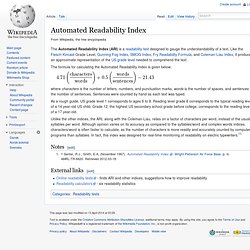

Flesch–Kincaid readability test. The Flesch–Kincaid readability tests are readability tests designed to indicate how difficult a passage in English is to understand.

There are two tests, the Flesch Reading Ease, and the Flesch–Kincaid Grade Level. Although they use the same core measures (word length and sentence length), they have different weighting factors. The results of the two tests correlate approximately inversely: a text with a comparatively high score on the Reading Ease test should have a lower score on the Grade-Level test. Rudolf Flesch devised the Reading Ease evaluation; somewhat later, he and J. Peter Kincaid developed the Grade Level evaluation for the United States Navy. History[edit] "The Flesch–Kincaid" (F–K) reading grade level was developed under contract to the U.S. The F–K formula was first used by the Army for assessing the difficulty of technical manuals in 1978 and soon after became a United States Military Standard.
Flesch reading ease[edit] Automated Readability Index. The Automated Readability Index (ARI) is a readability test designed to gauge the understandability of a text.

Like the Flesch-Kincaid Grade Level, Gunning Fog Index, SMOG Index, Fry Readability Formula, and Coleman-Liau Index, it produces an approximate representation of the US grade level needed to comprehend the text. The formula for calculating the Automated Readability Index is given below: where characters is the number of letters, numbers, and punctuation marks, words is the number of spaces, and sentences is the number of sentences. Sentences were counted by hand as each text was typed. As a rough guide, US grade level 1 corresponds to ages 6 to 8. Unlike the other indices, the ARI, along with the Coleman-Liau, relies on a factor of characters per word, instead of the usual syllables per word. Notes[edit] Jump up ^ Senter, R.J.; Smith, E.A. External links[edit]
Find a Book - Lexile Framework for Reading. Innovative Educator - Determine Readability Using Google or Microsoft. I recently attended a conference where I ran into a couple out-of-touch old timers who wanted to explain to me why things are the way they are.

The conversation went like this: The first guy said, “Ya know, nothing in life is free.” The next one chimed in, “Uh huh! Ya get what you pay for.” Followed by, “It takes a lot to bring schools into the 21st century. Expensive equipment. Listening to these guys made me want to scream. The two men looked at me and then each other shaking their heads. So, I retorted. People like these old-timers need to hold on to this reality and convince others of it’s truth not only because folks are resist to change, but because it keeps them employed. There is a lot at stake for these old timers and big businesses if educators don't believe their in-the-past reality. 8 Free and Easy Tools Innovative Educators Can Start Using Today The following tools are all free and simple to use. The Tool: Poll Everywhere.